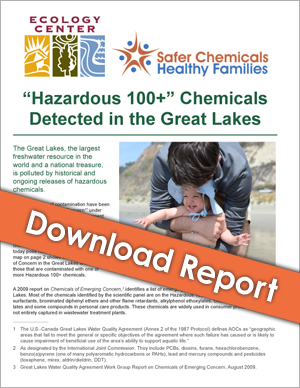I am a Great Lakes enthusiast; in fact my love of the lakes is one of the driving forces that led me to this work. I spend my summer vacation on Lake Superior, took frequent camping trips along the North Shore of Superior in college, and have enjoyed friend’s weddings along the banks of Lake Michigan.
There’s something about the Great Lakes that hooks us. Whether or not you live in a Great Lakes state, if you’ve experienced their beauty you know how important it is to protect them.
That’s why dozens of Great Lakes organizations have come together to ask the nation’s top ten retailers to protect these valuable resources from toxic chemical pollutants. As part of the letter to retailers, the organizations attached a new fact sheet highlighting some of the new science around toxic chemical pollutants in the Great Lakes, including the nasty “PBT” chemicals that stay in the environment, to “emerging contaminants” like Triclosan, which are rapidly rising as Great Lakes pollutants.
Our partners at the Ecology Center recently mapped out where some of the Hazardous 100+ chemicals are ending up in the lakes. Toxic chemicals have a variety of routes they travel: some are released directly from manufacturing sites or creep their way out of landfills into the ground water, rivers and lakes, while others are the result of legacy pollution from days past.
Contrary to popular belief, most waste-water treatment facilities aren’t equipped to filter out many chemical pollutants like hormone-disrupting chemicals and toxic flame retardants. The threat to our Great Lakes environment is also a threat to our health.
Some of the highlights from the Great Lakes fact sheet:
- A 2009 report on Chemicals of Emerging Concern, identifies a list of emerging chemicals that pose a threat to the Great Lakes. Most of the chemicals identified by the scientific panel are on the Hazardous 100+ list.
- After testing fish in the Great Lakes for toxic flame retardants (PBDEs), scientists found that levels of these flame retardants rose quickly during the 1980s, and the levels doubled in fish over a short span of three years.
- Triclosan, commonly used in antibacterial soaps, hand sanitizer and other consumer products has been detected as a Great Lakes contaminant.
- Great Lakes trout (one of my favorite treats) have been found to contain perflurochemical surfactants.
For more information on chemicals in our consumer products and manufacturing in the Great Lakes, you can read our full fact sheet here.
The point remains: our health, environment, water quality, fish, birds and air are all worth protecting. We need stronger federal laws on toxic chemicals, and we also need retailers to play a major role in moving the market away from toxic chemicals commonly used in consumer products.





